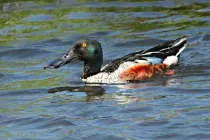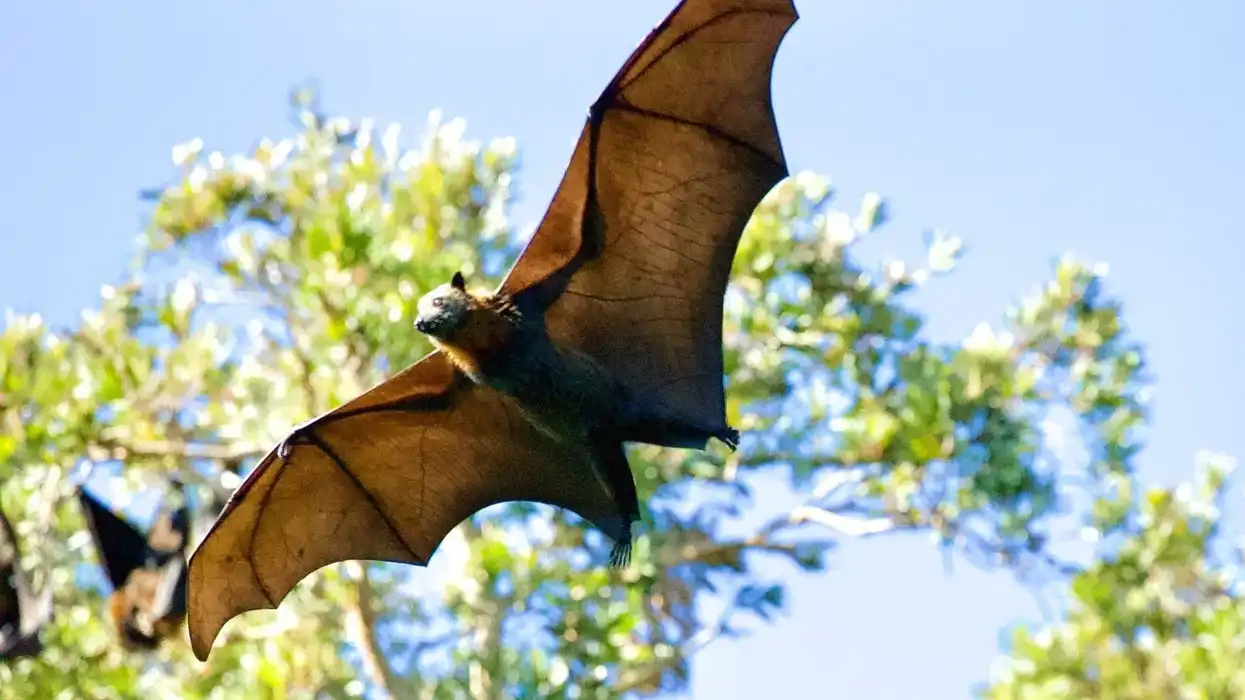Northern shoveler birds are usually seen foraging with their head down in shallow wetlands. Many of these ducks, due to their flat beaks, strain food particles from the water. They have often been seen swimming and straining food particles from the muddy soup of shallow waters.
Both males and females have different patterns and colorings. The male duck is said to have white breasts, an iridescent green head, and chestnut-brown flanks. The female bird mainly has a pattern of buffs and brown feathers. Their bill is dark gray, and they have yellow eyes.
Northern shoveler females build nests and incubate their eggs. The female lays white and olive-colored eggs and the incubation period lasts between 22 to 25 days.
After breeding, male birds are seen grouping together in small flocks. The male bird is also spotted molting its flight feathers before migrating to the south.
The basic food of these northern shoveler birds involves crustaceans, mollusks, small minnows, insects, larvae, seeds, and aquatic plants. According to the IUCN, the conservation status of this spoon-shaped bill shoveler bird has been declared as Least Concern.
Here on our page, we have lots of interesting facts on the northern shoveler that everyone can enjoy. So take look at these interesting facts, and if you like these, then do read our eared grebe and harlequin duck facts too!
Northern Shoveler Interesting Facts
What type of animal is a northern shoveler?
The northern shoveler (Spatula clypeata) is a duck species that is found living near wetlands, marshes, and lagoons. A northern shoveler duck is a medium-sized duck with a huge, spoon-shaped bill.
What class of animal does a northern shoveler belong to?
Northern shoveler ducks are classified as birds, from the Aves class. These spoon-shaped billed ducks are found in various regions of North America, Europe, and northern Asia. This North American bird species is not often seen foraging on land, but they rest on land and often walk along wetland edges.
How many northern shovelers are there in the world?
The population of these North American ducks is increasing around the world. At present, the global breeding population of this species of ducks is 4.5 million.
Where does a northern shoveler live?
Northern shovelers (Anas clypeata) are found living near aquatic regions like wetlands, marshes, and lagoons. These spoon-shaped billed ducks are found nesting in North America, Europe, and northern Asia. Also, during winter, they migrate to South America, North Africa, and southern Asia.
What is a northern shoveler's habitat?
The northern shoveler's basic habitat is in submerged vegetation during the breeding season. They are also spotted nesting along the margins of grassy areas. These birds are seen foraging in salt marshes, estuaries, lakes, flooded fields, shallow wetlands, agricultural ponds, and wastewater ponds.
Who do northern shovelers live with?
Northern Shovelers are seen living with the species of their own kind. Since in order to survive, they prey upon crustaceans, mollusks, small minnows, insects, larvae, seeds, and aquatic plants. As such, they are also seen co-existing with these different aquatic species of animals and birds.
How long does a northern shoveler live?
The lifespan of a northern shoveler bird (Anas clypeata) is 18 years in the wild.
How do they reproduce?
After mating with a male, a female northern shoveler lays eggs. She will lay around eight to 12 eggs and the breeding season takes place in spring between early April and June.
Northern shoveler female birds build nests and incubate their eggs, which are generally white and olive-colored.
The incubation period for these eggs lasts between 22 to 25 days. Males help the female bird to take care of the eggs, but after breeding, male birds are seen grouping together in small flocks and molting their flight feathers before migrating to the south.
What is their conservation status?
According to the IUCN, the conservation status of this northern shoveler bird has been declared as Least Concern. This means that they are free from the threats of becoming extinct or vulnerable.
The population of this North American bird is actually increasing around the world, and at present, the global breeding population of this species of ducks is 4.5 million.
Northern Shoveler Fun Facts
What do northern shovelers look like?
Northern shovelers are known for having a huge, spoon-shaped bill. Both males and females have different patterns and colorings. The male duck is said to have a white breast, an iridescent green head, and chestnut-brown flanks. The female bird mainly has a pattern of buffs and brown feathers.
Their bill is dark gray, and they have yellow eyes. They are also known for having comb-like teeth. Their wings can be blue, green, brown, or red.
How cute are they?
The northern shoveler bird is extremely cute and attractive!
How do they communicate?
Vocalization is the main mode of communication for these ducks. They make noises and use their oratory senses a lot too.
How big is a northern shoveler?
A northern shoveler bird is about 30 in (76 cm) long and is around 19 in (48 cm) tall. These northern shoveler birds are about nine times bigger than a rat.
How fast can a northern shoveler fly?
The speed at which a northern shoveler bird can fly is 40.8 mph (65.7 kph).
How much does a northern shoveler weigh?
These northern shoveler birds weigh about 17-38 oz (470-1000 g).
What are their male and female names of the species?
The males and females of this species do not have specific names.
What would you call a baby northern shoveler?
Baby northern shoveler ducks are called ducklings.
What do they eat?
The basic diet of these northern shoveler birds includes crustaceans, mollusks, small minnows, insects, larvae, seeds, and aquatic plants. These ducks actively forage head-down in shallow wetlands.
Are they dangerous?
No, they are not dangerous.
Would they make a good pet?
No, they are not a good pet. Humans cannot provide them with the atmosphere that they are adapted to live in.
Did you know...
The wingspan of a northern shoveler is about 30 in (76 cm).
The basic food of these northern shoveler birds includes crustaceans, mollusks, small minnows, insects, larvae, seeds, and plants.
Defensive males of this duck species are often seen chasing intruders on the water and in the air.
They are known for having a huge, spoon-shaped bill. The plates on their bill are called lamellae.
You can call a northern shoveler by mimicking their nasal-like sounds.
Do northern shovelers migrate?
Yes, northern shovelers migrate short distances during the day and also at night in flocks, through central and western parts of the U.S. More importantly, these dabbling ducks also migrate long distances during winters.
Do northern shovelers play dead?
These dabbling ducks do not play dead, even when they feel threatened in their habitat. They move a lot and cannot pretend to be dead even for a minute.
Here at Kidadl, we have carefully created lots of interesting family-friendly animal facts for everyone to discover! Learn more about some other birds, including the blue-winged teal or the conger eel.
You can even occupy yourself at home by drawing one on our Northern shoveler coloring pages.










